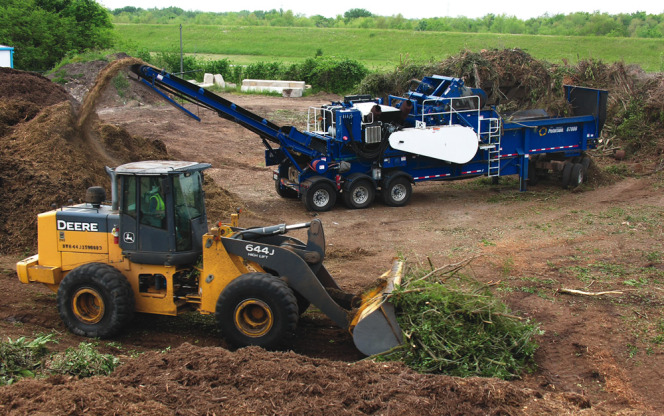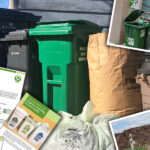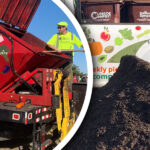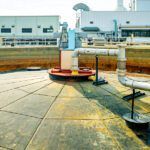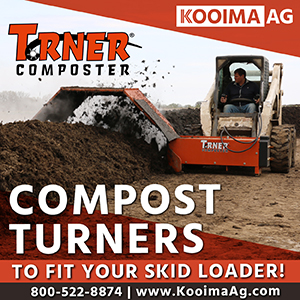Living Earth operates multiple composting facilities in Houston and Dallas-Ft. Worth, processing yard trimmings, produce “off-cuts,” bedding and manure.
Nora Goldstein
BioCycle January 2015
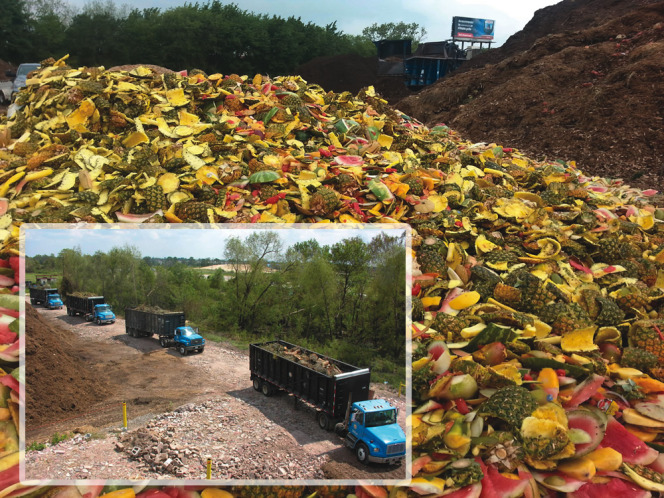
Feedstocks at Living Earth’s composting and mulch facilities include yard trimmings (inset) and preconsumer vegetative produce trimmings.
Mark Rose’s “career” in organics recycling started at age 13 when he had a job attaching empty bags to a bagging machine at a soil products company in Austin, Texas. “I’ve been in this business ever since,” he notes, “including managing the company where I worked as a kid.” Today, Rose is President and CEO of The LETCO Group LLC, which does business as Living Earth™, a Dallas-based composting and mulch production company with 18 processing facilities that include retail yards located in the Dallas-Ft. Worth region and Houston, and 3 stand-alone retail yards.
All together, Living Earth processes over 700,000 tons/year of yard trimmings, brush, preconsumer vegetative food discards, untreated wood wastes, stable bedding and herbivore manure. It composts the yard trimmings, manure and food scraps in large static piles. Brush and tree trimmings are processed separately into mulch. All Living Earth recycling facilities are open to the public and commercial businesses such as landscapers. In addition, the company has contracts with several municipalities to process curbside-collected brush and yard trimmings.
Living Earth opened its first organics recycling facility in 1985. Rose was one of the owners of the original company. In 1990, Republic Services — then a “little, little” company, notes Rose — purchased four companies in Texas, including Living Earth. “I then worked for Republic for 17 years,” he says. “Composting sites were opened at three landfills — one in Houston and two in Dallas-Forth Worth. Overtime, we had a mission to grow the company’s organics recycling infrastructure in the region. Our strategy was to develop conveniently located ‘in-field’ facilities that are in the city and accessible to our landscape customer base and various solid waste haulers, as well as our retail yard customers.”
In 2007, when Republic Services was preparing to merge with Allied Waste, Republic determined that Living Earth was a “noncore company” and decided to sell it. Rose joined with other Living Earth managers and an investment group to purchase the company, which today has 210 employees.
Organics Recycling Economics
With processing facilities located in the cities it services, Living Earth limits itself to accepting feedstocks that are not extremely odorous. Another limiting factor is low landfill tipping fees, which makes it difficult to set higher gate fees for source separated organics that may have higher levels of contamination. “It costs about $25 a ton to landfill waste in this region, which is too low to be able to take in more contaminated material that requires higher processing costs,” explains Rose. “We would be looking at fees of over $40/ton, and that just isn’t realistic in this solid waste market.”
He estimates that tipping fees at Living Earth’s processing sites account for about 11 percent of the company’s total revenue. “The rest is product sales,” he adds, “which is why we need to keep things clean. We have always been strong at marketing, and making sure we evolved in a manner where we had a home for everything we made first before expanding.”
The preconsumer vegetative food waste consists primarily of off-cuts from companies that process fresh produce. As it is tipped, a worker inspects loads and removes the occasional trash bag or other contaminant. A loader operator combines the food waste with yard trimmings and stable bedding, and pushes it into an initial pile; material from the pile is fed into a grinder, and then put into a static pile for composting. Roughly midway through the 4-month (on average) composting process, material is ground again and goes into a curing phase.

Brush collected curbside every other month by the City of Houston is brought to Living Earth for processing into mulch, which is bagged and sold at retail outlets (blue bags in center above). The City also collects yard trimmings in compostable bags that are composted at Living Earth.
The company has eight grinders (including Peterson, Vermeer and Diamond Z brands), seven of which are horizontal. “We have one tub grinder and like the productivity and texture of the ground material, but given our proximity to the surrounding community, we limit its use due to the potential of projectiles,” explains Rose. “Instead of having investments tied up with huge equipment at all sites, we move the grinders, which are mobile, as needed to different sites in the area.”
About 2.5 million cubic yards of compost and mulch are produced and sold annually. The compost is certified through the US Composting Council’s Seal of Testing Assurance (STA) program. While much of the end product is sold in bulk to landscape contractors, Living Earth also bags its compost, mulch and soil products for retail sale at garden centers and big box stores. “We have four bagging lines in Houston and two in Dallas, and primarily use equipment manufactured by Amadas,” he says. “We also sell a lot of our product to the Texas Department of Transportation (TxDOT) for erosion control and storm water management. TxDOT requires that the compost be STA-certified. Some landscape contractors also require an STA compost.”
Municipal Contracts
Living Earth has several established municipal accounts, processing organics from curbside and drop-off collection programs operated by municipalities. “For example, in April 2009, the City of Houston implemented an every-other-month brush collection program,” explains Lora Hinchcliff, Living Earth’s Municipal Solutions Manager. “Living Earth partnered with the City of Houston to process the tree debris collected by sanitation crews. With this guaranteed influx of new material, we opened another recycling facility to accommodate city trucks, reducing haul time, and providing the City of Houston with four recycling drop-off sites in each of the City’s service quadrants.”
Living Earth’s management team developed a packaged product, Houston Mulch™, distributing it through local garden centers, major retail outlets, and each Houston area Living Earth location. The bag itself works as an education tool, demonstrating the closed loop process, e.g., “Made from Trees and Brush Collected in Houston,” “Processed and Packaged in Houston.” “The City receives a percent of sales from Living Earth for each bag of Houston Mulch sold,” adds Hinchcliff. “This money goes back into the recycling program fund. Since the tree debris collection program began, Living Earth has recycled 243,324 tons of brush for the City of Houston.”
In April 2010, Houston expanded its program to include curbside collection of yard trimmings in compostable bags. The city selected six brands of compostable bags certified by the Biodegradable Products Institute (BPI) that were tested at a Living Earth composting site. “All were run through our grinder and put in static piles, and within three weeks of receiving them, they were pretty much gone,” recalls Rose. “Two weeks later, they had completely degraded.”
The six selected brands of bags are sold to Houston residents in retail stores. They carry the Houston logo. “Due to the number of homes served by the city, residents are required to purchase and use these bags that carry the City of Houston logo,” says Hinchcliff. “This ensures residents are setting out the right type of compostable bag, as tested and approved by the City of Houston. Another benefit is minimization of contamination because the bags are translucent, making it easier for the crews to safely check the bags before loading.”
Rose has found that there is an adequate amount of woody material in the yard trimmings to keep the static piles porous enough during composting. “All of the brush is made directly into mulch as we don’t want that woodier material that looks ‘sticky or stemmy’ in our compost product,” he explains. “Residents can include small twigs with their yard trimmings, which is enough to give the composting piles porosity.” Overall, add Rose and Hinchcliff, “we have been continually impressed with the cleanliness of the material coming from the City of Houston’s curbside program. This is a reflection of the city’s commitment to the program’s success.”
Longer term, Living Earth envisions expanding its composting and mulch production services to other regions. “We are interested in forming additional partnerships with communities, waste hauling companies and landfill operators that need cost-effective solutions for their organics recycling,” notes Rose.
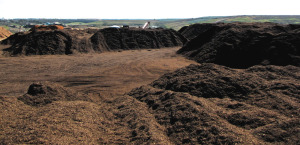
Materials are composted in static piles for about 4 months. Finished compost is certified through the US Composting Council’s STA program.
Compost Math
Living Earth, based in Dallas, Texas, processes 700,000 tons/year of organics and sells in excess of 2.5 million cubic yards (cy) of compost, mulch and soil blends annually in both bulk and bags. We asked Mark Rose, president and CEO of Living Earth, about how the company calculates total cubic yards produced from the 700,000 tons/year. Here’s Rose’s compost math:
“The 2.5 million cy does include the soil mixes but the weight of the sand and other additives [in our blends] is not included in the 700,000 tons — just the organics. And it includes the boiler fuel made out of waste wood, which weighs as little as 250 pounds (lbs)/cy or about 150 tons/day of boiler fuel. The biggest component of the soil mixes is the compost. When we make the soil mixes and add the soil and sand the volume really does not grow since we are typically adding heavier materials.
“The 700,000 tons is a very much studied conclusion. We have the produce waste that is basically slop weighing up to 3,000 lbs/cy, and green waste that is light, maybe as low as 400 lbs/cy. All the other material we take in for processing is in the middle of those two extremes. So when we have finished compost that typically weighs around 1,000 lbs/cy, mulches that weigh around 600-700 lbs/cy (which are our highest volume) and boiler fuel that is super light, that comes out to an average less than 600 lbs/cy.”



